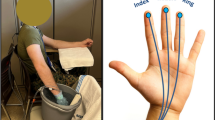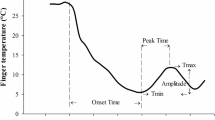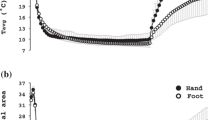Abstract
We investigated whether cyclic elevations in index finger temperature (cold-induced vasodilatation, CIVD) during prolonged cold exposure correlated with hand temperature and neuromuscular function. Evoked twitch force of the first dorsal interosseus (FDI) muscle was measured every minute in eight males and four females [age 25.4 (5.7) years, mean (SD)] during cooling of the hand for 30 min in 9°C water, and in thermoneutral 30°C water. During cooling, index finger temperature increased from 9.4 (0.9)°C at the nadir to 13.3 (2.4)°C (P<0.01) at the apex of the CIVD. However, the minimum skin temperature above the FDI muscle was 14.2 (2.1)°C, with no CIVD detected in any of the subjects. Peak twitch force was 2.5 (0.7) N at the nadir of the finger CIVD and 2.0 (0.8) N at the apex (P=0.07), time-to-peak increased from 189 (18) ms to 227 (26) ms (P<0.01), and half relaxation time increased from 135 (14) ms to 183 (32) ms (P<0.01). We conclude that CIVD is a local phenomenon isolated to the fingers, and that it does not have beneficial effects on either temperature or neuromuscular function of the FDI muscle during cold exposure.




Similar content being viewed by others
References
Bennett AF (1984) Thermal dependence of muscle function. Am J Physiol Regul Integr Comp Physiol 247:R217–R229
Bigland-Ritchie B, Thomas CK, Rice CL, Howarth JV, Woods JJ (1992) Muscle temperature, contractile speed, and motoneuron firing rates during human voluntary contractions. J Appl Physiol 73:2457–2461
Chen F, Liu ZY, Holmer I (1996) Hand and finger skin temperatures in convective and contact cold exposure. Eur J Appl Physiol 72:372–379
Cheung SS, Montie DL, White MD, Behm D (2003) Changes in manual dexterity following short-term hand and forearm immersion in 10°C water. Aviat Space Environ Med 74:990–993
Canadian Society for Exercise Physiology (1998) Canadian physical activity fitness and lifestyle appraisal. Canadian Society for Exercise Physiology, Ottawa, Canada
Daanen HA, Ducharme MB (1999) Finger cold-induced vasodilation during mild hypothermia, hyperthermia and at thermoneutrality. Aviat Space Environ Med 70:1206–1210
Daanen HA, Van de Linde FJ, Romet TT, Ducharme MB (1997) The effect of body temperature on the hunting response of the middle finger skin temperature. Eur J Appl Physiol 76:538–543
De Jong RH, Hershey WN, Wagman IH (1966) Nerve conduction velocity during hypothermia in man. Anaesthesiology 27:805–810
De Ruiter CJ, De Haan A (2000) Temperature effect on the force/velocity relationship of the fresh and fatigued human adductor pollicis muscle. Pflugers Arch 440:163–170
De Ruiter CJ, Jones DA, Sargeant AJ, De Haan A (1999) Temperature effect on the rates of isometric force development and relaxation in the fresh and fatigued human adductor pollicis muscle. Exp Physiol 84:1137–1150
Ducharme MB, VanHelder WP, Radomski MW (1991) Cyclic intramuscular temperature fluctuations in the human forearm during cold-water immersion. Eur J Appl Physiol 63:188–193
Foldes FF, Kuze S, Vizi ES, Deery A (1978) The influence of temperature on neuromuscular performance. J Neural Transm 43:27–45
Fox RH, Wyatt HT (1962) Cold-induced vasodilatation in various areas of the body surface of man. J Physiol (Lond) 162:289–297
Gagge AP, Stolwijk JA, Hardy JD (1967) Comfort and thermal sensations and associated physiological responses at various ambient temperatures. Environ Res 1:1–20
Giesbrecht GG, Bristow GK (1992) Decrement in manual arm performance during whole body cooling. Aviat Space Environ Med 63:1077–1081
Grant RT, Bland EF (1931) Observations on arteriovenous anastomoses in human skin and in the bird’s foot with special reference to the reaction to cold. Heart 15:385–411
Greenfield ADM, Kernohan GA, Marshall RJ, Shepherd JT, Wheland RF (1951) Heat loss from toes and fore-feet during immersion in cold water. J Appl Physiol 4:37–45
Heus R, Daanen HA, Havenith G (1995) Physiological criteria for functioning of hands in the cold. Appl Ergon 26:5–13
Keatinge WR (1957) The effect of general chilling on the vasodilator response to cold. J Physiol (Lond) 139:497–507
Keen DA, Yue GH, Enoka RM (1994) Training-related enhancement in the control of motor output in elderly humans. J Appl Physiol 77:2648–2658
Kreh A, Anton F, Gilly H, Handwerker HO (1984) Vascular reaction correlated with pain due to cold. Exp Neurol 85:533–546
Lewis T (1930) Observations upon the reactions of the vessels of the human skin to cold. Heart 15:177–208
Nowak DA, Hermsdorfer J (2003) Digit cooling influences grasp efficiency during manipulative tasks. Eur J Appl Physiol 89:127–133
Provins KA, Morton R (1960) Tactile discrimination and skin temperature. J Appl Physiol 15:155–160
Ranatunga KW, Sharpe B, Turnbull B (1987) Contractions of a human skeletal muscle at different temperatures. J Physiol (Lond) 390:383–395
Rutkove SB (2001) Effects of temperature on neuromuscular electrophysiology. Muscle Nerve 24:867–882
Sawada S, Araki S, Yokoyama K (2000) Changes in cold-induced vasodilatation, pain and cold sensation in fingers caused by repeated finger cooling in a cool environment. Ind Health 38:79–86
Wilson O, Goldman RF (1970) Role of air temperature and wind in the time necessary for a finger to freeze. J Appl Physiol 29:658–664
Acknowledgements
We would like to thank the subjects for their enthusiastic participation. The study was supported by a Discovery Grant (S. Cheung and G. Sleivert) from the Natural Sciences and Engineering Research Council of Canada (NSERC). C. Geurts was supported by a NSERC PGS-B scholarship.
Author information
Authors and Affiliations
Corresponding author
Rights and permissions
About this article
Cite this article
Geurts, C.L.M., Sleivert, G.G. & Cheung, S.S. Effect of cold-induced vasodilatation in the index finger on temperature and contractile characteristics of the first dorsal interosseus muscle during cold-water immersion. Eur J Appl Physiol 93, 524–529 (2005). https://doi.org/10.1007/s00421-004-1254-7
Accepted:
Published:
Issue Date:
DOI: https://doi.org/10.1007/s00421-004-1254-7




